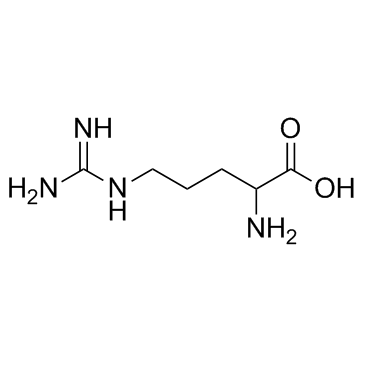DL-Arginine

DL-Arginine structure
|
Common Name | DL-Arginine | ||
|---|---|---|---|---|
| CAS Number | 7200-25-1 | Molecular Weight | 174.201 | |
| Density | 1.5±0.1 g/cm3 | Boiling Point | 367.6±52.0 °C at 760 mmHg | |
| Molecular Formula | C6H14N4O2 | Melting Point | 228-232ºC | |
| MSDS | Chinese USA | Flash Point | 176.1±30.7 °C | |
| Symbol |

GHS07 |
Signal Word | Warning | |
|
Influence of the lipid membrane environment on structure and activity of the outer membrane protein Ail from Yersinia pestis.
Biochim. Biophys. Acta 1848(2) , 712-20, (2014) The surrounding environment has significant consequences for the structural and functional properties of membrane proteins. While native structure and function can be reconstituted in lipid bilayer membranes, the detergents used for protein solubilization are... |
|
|
Blockage of GSK3β-mediated Drp1 phosphorylation provides neuroprotection in neuronal and mouse models of Alzheimer's disease.
Neurobiol. Aging 36(1) , 211-27, (2014) It is well established that mitochondrial fragmentation plays a key role in the pathogenesis of Alzheimer's disease (AD). Mitochondrial fission is mediated by dynamin-related protein 1 (Drp1), which is highly expressed in nervous system and regulated by vario... |
|
|
Acetyltransferase p300/CBP associated Factor (PCAF) regulates crosstalk-dependent acetylation of histone H3 by distal site recognition.
ACS Chem. Biol. 10(1) , 157-64, (2015) Epigenetic regulation is directed, in part, by the correlated placement of histone post-translational modifications, but the mechanisms controlling correlated modifications are incompletely understood. Correlations arise from crosstalk among modifications and... |
|
|
Silencing urease: a key evolutionary step that facilitated the adaptation of Yersinia pestis to the flea-borne transmission route.
Proc. Natl. Acad. Sci. U. S. A. 111(52) , 18709-14, (2014) The arthropod-borne transmission route of Yersinia pestis, the bacterial agent of plague, is a recent evolutionary adaptation. Yersinia pseudotuberculosis, the closely related food-and water-borne enteric species from which Y. pestis diverged less than 6,400 ... |
|
|
The tyrosine phosphatase PTPN14 (Pez) inhibits metastasis by altering protein trafficking.
Sci. Signal. 8(364) , ra18, (2015) Factors secreted by tumor cells shape the local microenvironment to promote invasion and metastasis, as well as condition the premetastatic niche to enable secondary-site colonization and growth. In addition to this secretome, tumor cells have increased abund... |
|
|
Mechanism of chemical activation of sodium chloride in the presence of amino acids.
Food Chem. 166 , 301-8, (2014) Sodium chloride has been shown to promote chlorination of glycerol during thermal processing. However, the detailed mechanism of this reaction is not well understood. Preliminary experiments have indicated that the reaction mixture should contain an amino aci... |
|
|
Conversion of the LIMA1 tumour suppressor into an oncogenic LMO-like protein by API2-MALT1 in MALT lymphoma.
Nat. Commun. 6 , 5908, (2015) MALT1 is the only known paracaspase and is a critical mediator of B- and T-cell receptor signalling. The function of the MALT1 gene is subverted by oncogenic chimeric fusions arising from the recurrent t(11;18)(q21;q21) aberration, which is the most frequent ... |
|
|
Simplified in vitro refolding and purification of recombinant human granulocyte colony stimulating factor using protein folding cation exchange chromatography.
J. Chromatogr. A. 1379 , 74-82, (2015) Protein folding-strong cation exchange chromatography (PF-SCX) has been employed for efficient refolding with simultaneous purification of recombinant human granulocyte colony stimulating factor (rhG-CSF). To acquire a soluble form of renatured and purified r... |
|
|
HSP90 inhibition enhances antimitotic drug-induced mitotic arrest and cell death in preclinical models of non-small cell lung cancer.
PLoS ONE 9(12) , e115228, (2014) HSP90 inhibitors are currently undergoing clinical evaluation in combination with antimitotic drugs in non-small cell lung cancer (NSCLC), but little is known about the cellular effects of this novel drug combination. Therefore, we investigated the molecular ... |
|
|
Silica-based nanofibers for electrospun ultra-thin layer chromatography.
J. Chromatogr. A. 1364 , 261-70, (2014) Nanofibrous silica-based stationary phases for electrospun ultra-thin layer chromatography (E-UTLC) are described. Nanofibers were produced by electrospinning a solution of silica nanoparticles dispersed in polyvinylpyrrolidone solutions to create composite s... |